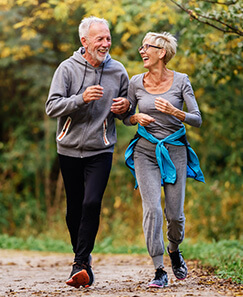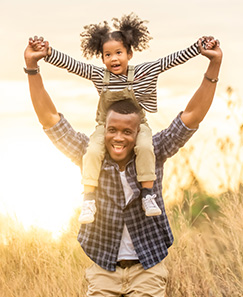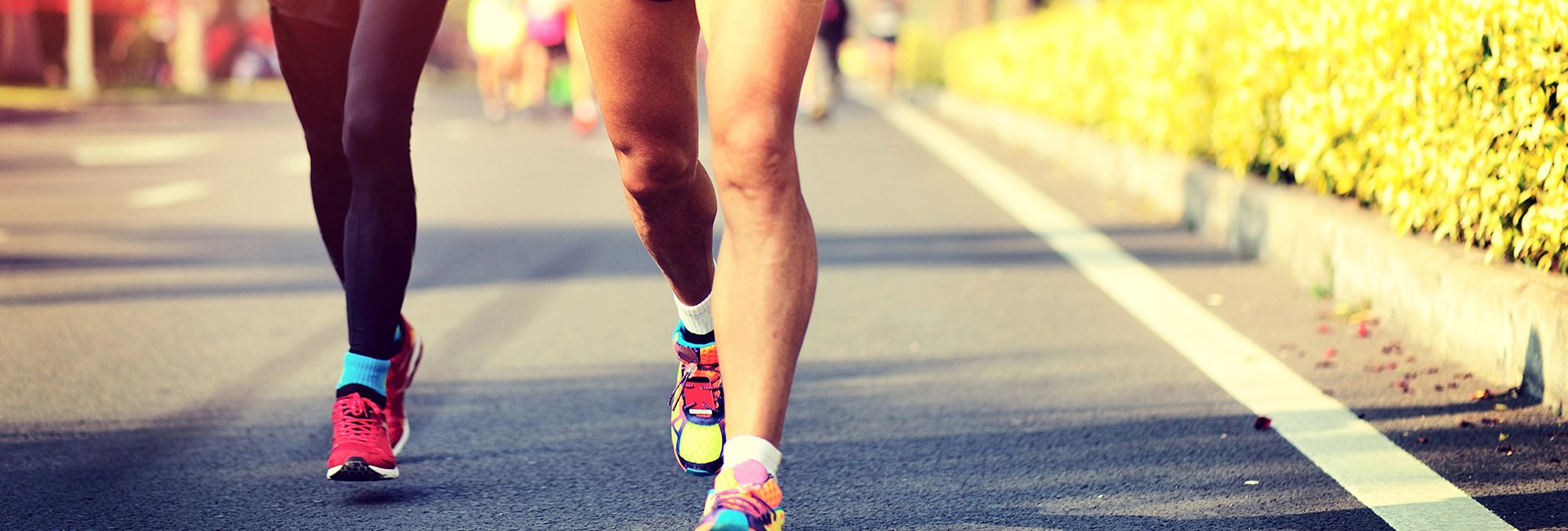Perform static stretches after running for muscles that are sore
Common areas of soreness in running are the quadriceps at the front of the thigh, hamstrings at the back of the thigh, hip rotators at the sides of the hips, and calves. See below for stretches that will help with post-running soreness.
Remain hydrated
Drink water throughout the day, and if running longer than 45 minutes in the heat, carry water or run a route through an area that has a drinking fountain. As weather gets warmer, consider running either early in the morning or later at night to avoid peak sun times.
Avoid the “too far, too fast, too soon” paradigm
Increasing mileage, duration, or speed too quickly can increase the risk for injury. When training, increase only one of these per week, and do so by 10%. This allows for muscles, tendons, and ligaments to become stronger and adapt at a safer rate to increased force during running.
If pain persists for greater than one week, go see a physical therapist.
Core stretches for men and women
Mobility is the ability of segments of the body to move or be moved, allowing a range of motion for functional activities. Mobility is associated with joint integrity as well as the flexibility or extensibility of soft tissues (muscles, tendons, fascia, joint capsules, and skin) that cross or surround joints.
Hypomobility (restricted motion) is caused by adaptive shortening of soft tissues that can occur as the result of a disorder or situation. These could include prolonged immobilization of a body segment, sedentary lifestyle, postural malalignment/muscle imbalances, and muscle weakness, tissue trauma resulting in inflammation and pain, or congenital/acquired deformities.
Both males and females are prone to hypomobility if they do not take preventative measures, such as sticking to a stretching routine. Both runners and walkers commonly have low back pain, which may stem from tight hamstrings and quadriceps. The following are exercises focused on flexibility that will help to eliminate pain and address any hypomobility issues.
Cat back
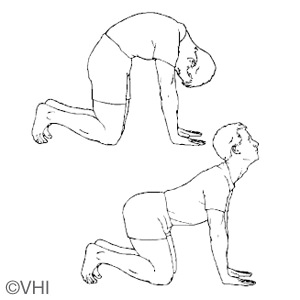
Relax back into arch, keeping head up while inhaling. Then push up into a rounded back as you exhale. Hold 5 seconds in each position.
Knee spiral
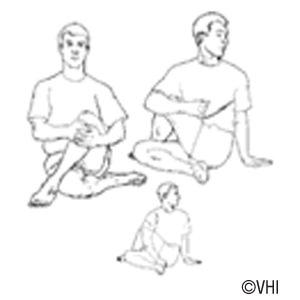
Sit with straight back, crossing left leg over bent right leg. Hold left knee with right hand and spiral to left. Support position with left hand on floor. Hold for 5 breaths. Repeat on other side. ADVANCED: Grasp heel of right foot.
Rise up
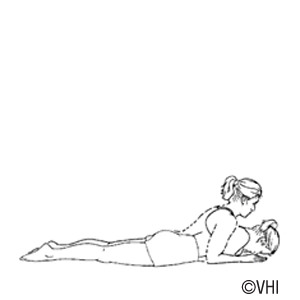
Rise up on elbows as high as possible, keeping hips on floor. Hold 20-30 seconds.
Lower trunk rotation
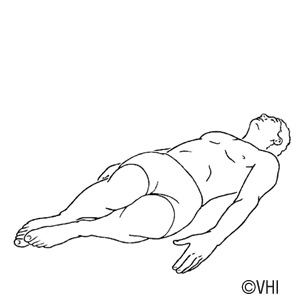
Keeping back flat and feet together, rotate knees to either side – slowly alternate side to side.
Reach
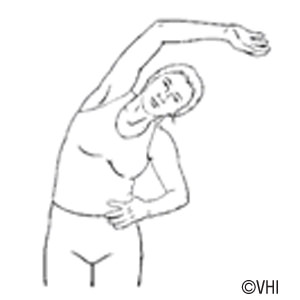
Reach over head to other side with right arm until stretch is felt. Alternate sides. Specific to triceps, lats, quadrants lumborum, and oblique abdominals.
Hamstring wall
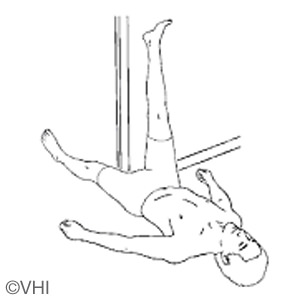
Laying on floor with right leg on wall, other leg through doorway, scoot buttocks toward wall until stretch is felt in back of thigh. As leg relaxes, scoot closer to wall. Alternate legs. Back protected against floor.
Press Upper Body
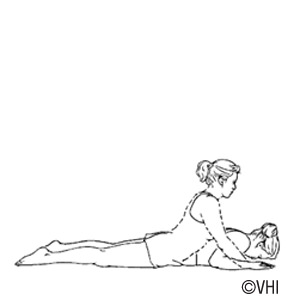
Press upper body upward, keeping hips in contact with floor. Keep lower back and buttocks relaxed. Hold 20-30 seconds.
Spinal stretch rising sun
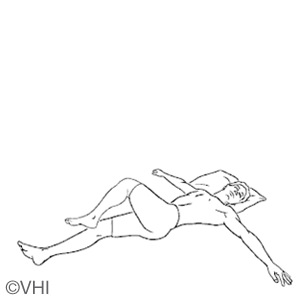
Lie on back with left knee drawn toward chest. Slowly bring bent leg across body until stretch is felt in lower back/hip area. Alternate sides.
Hip flexors
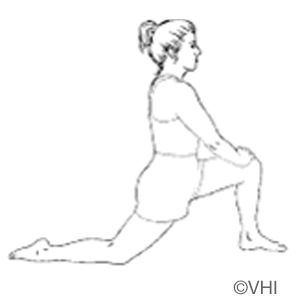
Kneeling on right knee, slowly squeeze and tuck buttocks under to Rotate pelvis until a stretch is felt in the anterior hip. Lunge forward with left leg to increase intensity.
Backward bend
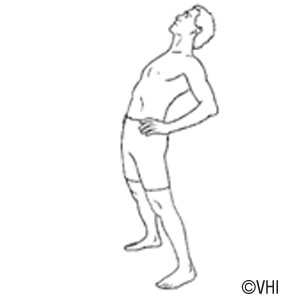
Arch backward to make hollow of back deeper. Hold 10 seconds.
Lower body stretching for men and women
Flexibility is trainable – and is intrinsic to every athletic skill or technique, no matter how simple, complex, or power-oriented. It is also movement-specific, which is why increasing a single joint’s range of motion is not the only objective. Through a combination of functional stretching and strengthening routines, muscles and tendons can increase in length and girth, elasticity and resiliency, as well as their ability to act in a ballistic “spring-like” manner during explosive movements.
To achieve optimal gains in flexibility:
- Perform exercises in a full range of motion. This improves the ability to safely and effectively use range of motion during dynamic movements.
- Stretch only once muscles are warmed up. When muscles are cold, they are resistant to lengthening and will not receive as good of a stretch. “Warm up to stretch, don’t stretch to warm up.”
- Before working out, perform a dynamic warm-up of each muscle that will be worked during the walk, run, or workout. Then perform static stretching after working out.
- Static stretching should be performed at the end of a training session, as this is the best time to relax and develop maximum flexibility with muscles that are pre-exhausted and thoroughly warmed up. Doing so will result in less soreness and quicker recovery between workouts.
Key principles
- When static stretching, be in a position to feel each stretch in the belly of the muscle(s) and not the joint(s).
- In order to have a beneficial effect, each stretch must begin gradually and be held long enough for the tightness to subside.
- Statically (without bouncing) stretch each muscle group to a personal comfort limit for approximately 30 seconds; relax and repeat. Push the stretch a little further with each successive repetition.
- Stretching should NOT be painful.
Hamstring (standing)
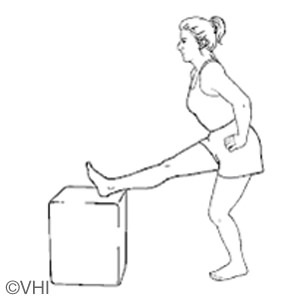
Place right foot on stool. Slowly lean forward at your hips, keeping back straight, until stretch is felt in back of thigh. Hold 30 seconds. Repeat with left leg.
Hamstring (sitting)
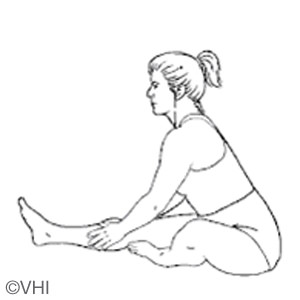
With right leg straight, tuck other foot near groin. Reach down until stretch is felt in back of thigh. Keep back straight. Hold 30 seconds. Repeat with left leg.
Gastrocnemius
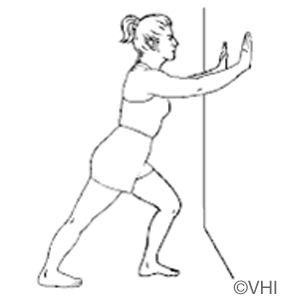
Stand with right foot back, leg straight, forward leg bent. Keeping heel on floor, toes pointed forward, lean into wall until stretch is felt in calf. Hold 30 seconds. Repeat with left leg back.
Soleus
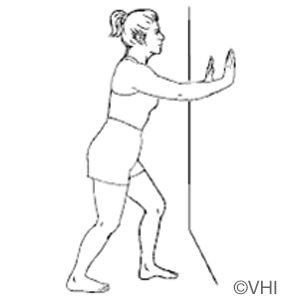
Stand with right foot back, both knees bent. Keeping heel on floor and toes pointed forward, lean into wall until stretch is felt in lower calf. Hold 30 seconds. Repeat with left leg back.
Quadriceps (standing)
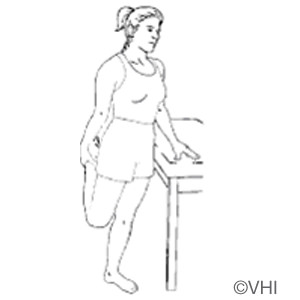
Pull right heel toward buttock until stretch is felt in front of thigh. Make sure to keep abdominals tight, keep knees together, and do not arch low back. Hold 30 seconds. Repeat with left leg.
Hip flexors

Kneeling on right knee, slowly squeeze and tuck buttocks under to rotate pelvis until a stretch is felt in the anterior hip. Lunge forward with left leg to increase intensity.
Pigeon pose
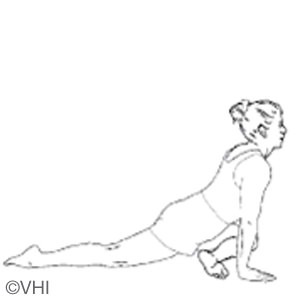
From hands and knees, slide right leg back and turn bent left leg out slightly to side. Resting weight on outside of left leg, push up torso with arms until stretch is felt on left hip and glutes. Hold 30 seconds. Repeat on other side.
Piriformis/gluteals (supine)
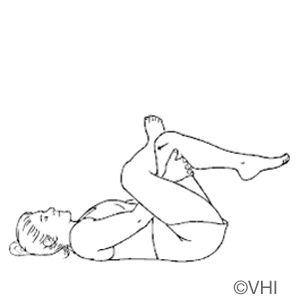
Cross right leg on top of left thigh. Gently pull left knee toward chest until stretch is felt in buttock/hip of top leg. Hold 30 seconds. Repeat with left leg on top of right thigh.
Inner thigh/groin/adductors
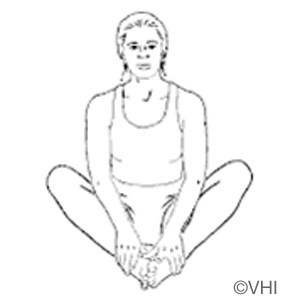
Place heels together and pull feet toward groin until stretch is felt in groin and inner thigh. Keep back straight. Hold 30 seconds.
Tensor fasciae latae (TFL) and iliotibial band (IT band)
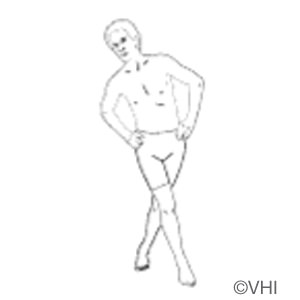
Cross right leg over the left, then lean to right side until stretch is felt on left hip. Hold 30 seconds. Repeat by crossing left leg over right to stretch the right hip.
Upper body stretching for women
There are many different ways to stretch the body. This program addresses flexibility focused on the upper body. All stretches should be held 20-30 seconds in a static position – no bouncing. If an adequate stretch is not felt, check posture and positioning. Stretch only to the point of a “pull” and never to the point of pain. Pushing through pain increases the risk for injury.
Focus on a breathing pattern while stretching. Make sure to inhale from “the belly” and not the upper chest. Frequently try to increase the stretch on an exhale. In order for stretches to be most effective, they should be performed regularly, preferably daily. Stretching can be performed any time of the day, but it tends to be most effective when muscles are warm and performed as a recovery routine to a recent run or walk.
Chest: pectorals
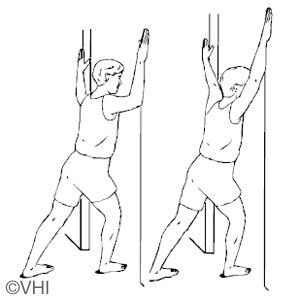
Place forearms on door frame. Step forward, allowing chest to stretch. Hold 30 seconds. Repeat 3 times. Do 1 session per day.
Cervical spine: levator scapula
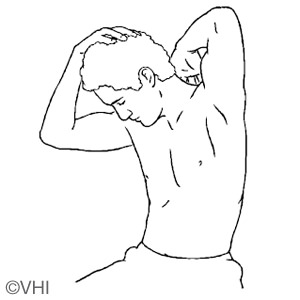
Place left hand behind back. With other hand, gently stretch head down and away. Hold 30 seconds. Repeat 3 times per set. Do 1 set per session. Do 1 session per day.
Arms: biceps
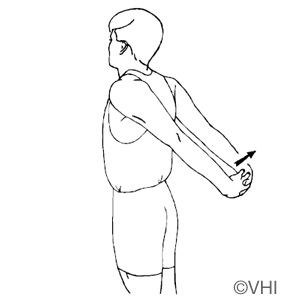
With arms straight and fingers interlaced, raise arms until stretch is felt. Hold 30 seconds. Repeat 3 times. Do 1 session per day.
Neck: side benders
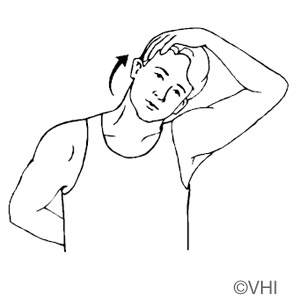
Gently grasp side of head with one hand, placing the other hand behind back. Tilt head away until a gentle stretch is felt. Hold 30 seconds. Repeat to other side. Repeat 3 times. Do 1 session per day.
Shoulders: rotator cuff/extensors
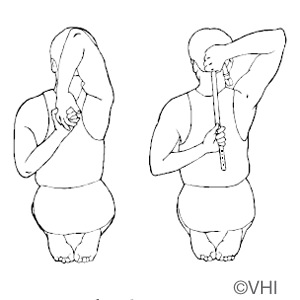
Bring right hand behind head and down as far as possible. Reach up with left hand, palm facing out, and grasp right hand. Hold 30 seconds. May use belt as a beginner aid to help work hands closer together. Repeat with other side. Repeat 3 times. Do 1 session per day.
Arms: triceps
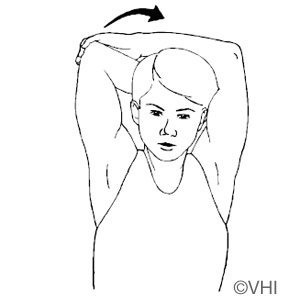
Pull elbow behind head until stretch is felt. Repeat with other elbow. Hold 30 seconds. Repeat 3 times. Do 1 session per day.
Cat back

On hands and knees, exhale and round back up. Inhale and arch back down. Hold for 3 breaths.
Hand: wrist extensor
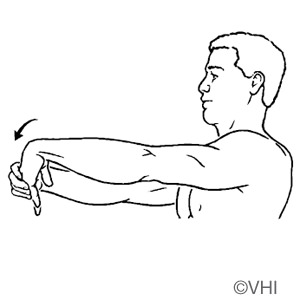
Keeping elbow straight, grasp left hand and slowly bend wrist forward until a stretch is felt. Hold 30 seconds. Relax. Repeat 3 times per set. Do 1 set per session, and 1 session per day.
Arms: wrist/flexors
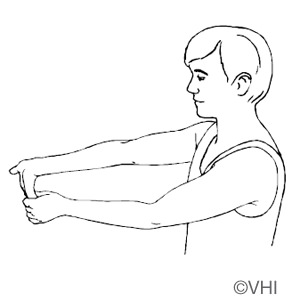
Stretch arm out in front with elbow straight and palm facing away. With other hand, pull fingers backward until a stretch is felt over inside of forearm. Hold 30 seconds. Repeat 3 times. Do 1 session per day.
Shoulders: extensors (standing)
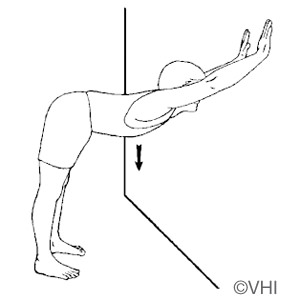
With hands on wall or rail and feet shoulder-width apart, move chest toward floor. Hold 30 seconds. Repeat 3 times. Do 1 session per day.
Shoulders: extensors (kneeling)
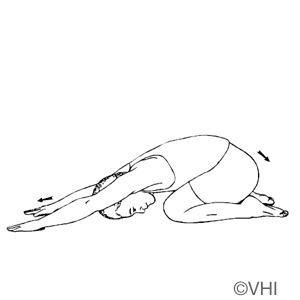
From kneeling position, slide arms forward while pushing buttocks toward floor. Hold 30 seconds. Repeat 3 times. Do 1 session per day.
Modified seated spiral
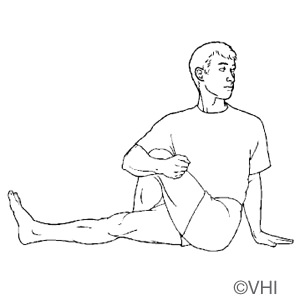
Sit with straight back, crossing left leg over straight right leg. Hold left knee with right hand and spiral torso left. Support position with left hand on floor. Hold for 20 breaths. Repeat on other side.
Posterior deltoids/rhomboids
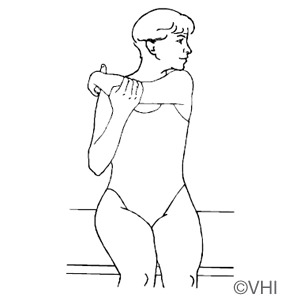
Pull arm across chest until stretch is felt. Turn head away from pull. Hold 30 seconds. Repeat with other arm. Repeat 3 times. Do 1 session per day.
Upper body stretching for men
Upper-body flexibility is important in maintaining a relaxed running stride. Unnecessary loss of energy occurs when a runner carries tension in their head, neck, and upper body, which negatively effects performance. The following stretches will enhance upper-body function throughout training.
Start with a gentle stretch and hold the position for at least 30 seconds. During this time, take up the “slack” in the muscle as the release is felt. This may need to be done several times during a stretch. Repeat this process 4 times for each muscle group and up to 4 times per day.
Arms: biceps

With arms straight and fingers interlaced, raise arms until stretch is felt. Hold 30 seconds. Repeat 3 times. Do 1 session per day.
Shoulders: rotator cuff/extensors

Bring right hand behind head and down as far as possible. Reach up with left hand, palm facing out, and grasp right hand. Hold 30 seconds. May use belt as a beginner aid to help work hands closer together. Repeat with other side. Repeat 3 times. Do 1 session per day.
Chest: pectorals

Place forearms on door frame. Step forward, allowing chest to stretch. Hold 30 seconds. Repeat 3 times. Do 1 session per day.
Neck: side benders

Gently grasp side of head with one hand, placing the other hand behind back. Tilt head away until a gentle stretch is felt. Hold 30 seconds. Repeat to other side. Repeat 3 times. Do 1 session per day.
Back: lumbar rotation

Lie on back with left knee drawn towards chest. Slowly bring bent leg across body until stretch is felt in lower back/hip area. Hold 30 seconds. Repeat 4 times on each side. Do 4 sessions per day.
Shoulder: posterior capsule
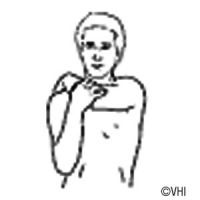
Gently pull on left forward elbow with other hand until stretch is felt in shoulder. Hold 30 seconds. Repeat 4 times on each arm. Do 4 sessions per day.
Shoulder: inferior capsule
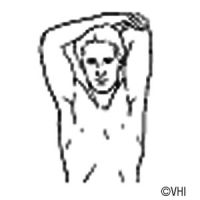
Gently pull on left raised elbow with other hand until stretch is felt in shoulder. Hold 30 seconds. Repeat 4 times on each arm. Do 4 sessions per day.
Start your journey to pain-free living today.
Our experts are committed to providing effective, efficient, and compassionate care to help you live a pain-free, active life. Our passion is to help every patient reach their goals on their journey to recovery and optimal performance.
